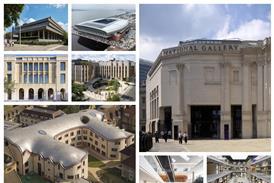- Home
- Intelligence for Architects
- Subscribe
- Jobs
- Events

2025 events calendar Explore now 
Keep up to date
Find out more
- Programmes
- CPD
- More from navigation items
Materialized Space: The Architecture of Paul Rudolph

Paul Rudolph’s visionary architecture helped shape mid-20th-century modernism, yet his work faces an enduring struggle for recognition and preservation. A new book, to accompany a major retrospective at the Metropolitan Museum of Art, offers a vital reappraisal, finds Jon Wright
Paul Rudolph’s work has remained dangerously undervalued since his death in 1997, despite his stellar career as a designer and teacher. Wilful destruction has seen the loss of his superb 1972 house in Westport in 2007, the Biggs Residence in Delray, Florida in 2020, and the high-concept Burroughs Wellcome Centre in North Carolina – which met the wrecking ball in 2022 despite a campaign to save it. There have been numerous other unnecessary losses that largely mirror the UK’s own difficulties in protecting post-war buildings. Elsewhere, force majeure has taken over, and the recent destruction of his Sanderling Beach Club in Florida by Hurricane Helena has meant another piece of his oeuvre is lost to us.
That there is a Rudolph-shaped gap in our wider understanding of 20th-century architecture is something of a surprise, as he was a major figure in the 1950s and 60s. He suffered a huge decline in popularity as postmodernism dawned, and history hasn’t been kind to him or his buildings; even Kenneth Frampton’s famous critical account of the period gives no mention of him or his work.
…
This content is available to registered users | Already registered?Login here
You are not currently logged in.
To continue reading this story, sign up for free guest access
Existing Subscriber? LOGIN
REGISTER for free access on selected stories and sign up for email alerts. You get:
- Up to the minute architecture news from around the UK
- Breaking, daily and weekly e-newsletters
Subscribe to Building Design and you will benefit from:

- Unlimited news
- Reviews of the latest buildings from all corners of the world
- Technical studies
- Full access to all our online archives
- PLUS you will receive a digital copy of WA100 worth over £45
Subscribe now for unlimited access.






